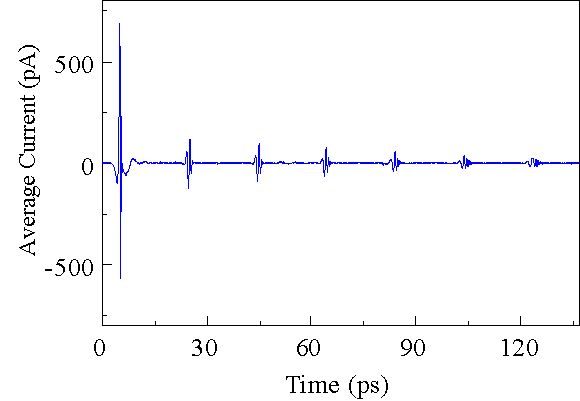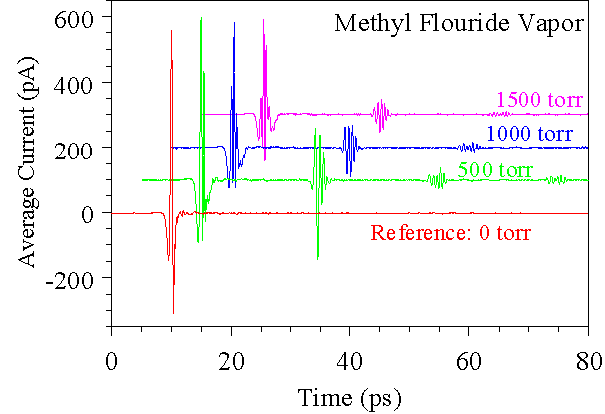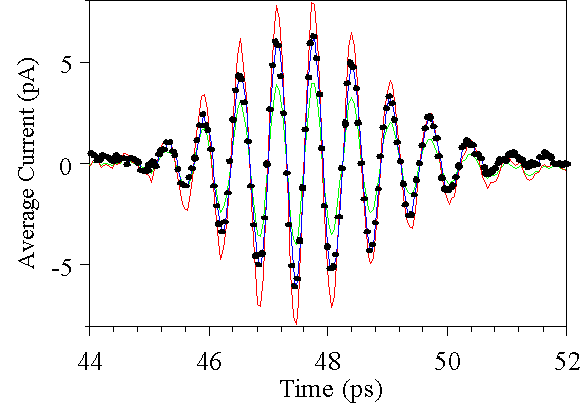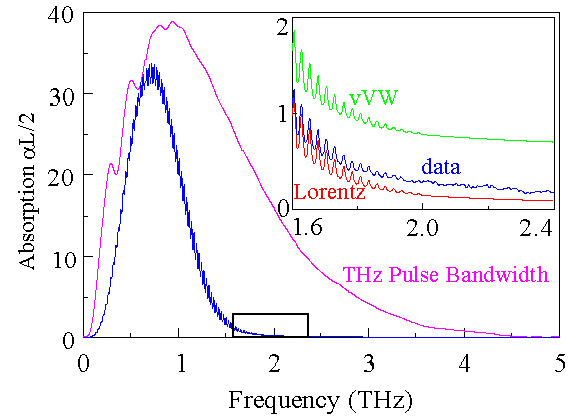Ultrafast THZ Optoelectronic Laboratory
Molecular Vapors
THz Studies of Collision Broadened Rotational Lines
Using our THz-TDS system we are performing an experimental and theoretical study of coherent transient effects resulting from the interaction of electromagnetic radiation with resonant systems. These experiments are based on exciting molecular vapors with freely propagating subpsec pulses of THz radiation and detecting the free-induction decay (FID) reradiated by the vapors. The propagation of a THz pulse through a molecular vapor simultaneously excites a manifold of rotational transitions, thereby causing the molecules to radiate a FID signal. Since the molecules studied in this investigation are distinguished by absorption lines with an almost constant frequency spacing, after the initial THz excitation a periodic rephasing and dephasing of the entire ensemble of excited rotational transitions occurs during the free induction decay. This rephasing process is manifest as a train of subpsec THz pulses with a repetition rate equal to the frequency separation between adjacent lines. These echos are shown in the figure below for a low pressure gas sample of methyl fluoride.
These echoes carry almost complete information about the molecular system. We obtain the molecular constants, and from the echo decay the coherence relaxation time T2 , determined only by collisional dephasing. Owing to the high signal-to-noise ratio and the exceptional time resolution, the lineshape and the strong variation of the pressure broadened linewidths over the rotational spectrum can be obtained, as well as important information on the collision behavior and intermolecular forces. For the higher frequencies of optical and infrared transitions, it is well known that the simple Lorentzian lineshape provides excellent agreement with experiment, particularly for the central region of the line. As the frequencies are reduced to those of the microwave or far-infrared region the absorption profile of a spectral line is better represented by a van Vleck-Weisskopf lineshape. We have extended such lineshape investigations to THz frequencies with the goal of gaining some insight into the actual collision process itself.
Based on the results of our experiments we have developed a molecular response theory based on molecular orientation times during a collision that models the transition from van Vleck-Weisskopf to Lorentzian theory. This theory provides the first dielectric response function describing such a system, where the collision duration occurs naturally in the theory together with the mean time between collisions.
All information contained in the frequency dependent amplitude and phase spectra of the molecular vapor is contained in the free induction decay signal measured directly in the time domain. The 20 psec temporal spacing between the coherent transients in the figure above corresponds to the inverse frequency spacing (approximately 50 GHz) of the rotational lines of methyl fluoride and the decay of the commensurate echo amplitude provides information on the collisional dephasing time T2 . This can be seen more dramatically in the figure below, where the response of methyl fluoride is shown as a function of increasing pressure in the time domain
The rotational line manifolds can be seen in the corresponding frequency domain spectra shown below, obtained by a numerical Fourier transform from the time domain measurements. As the pressure increases, the rotational band which is clearly visible at low pressures, becomes nearly a smooth curve at high pressure when the lines already strongly overlap.
We verified our molecular response theory by carefully modeling the response in the time domain. The pulse structure calculated for the first echo in methyl chloride using a collision parameter of C =220 fs is shown in the figure below. The calculated structure for the first echo using the van Vleck-Weisskopf lineshape (green) results in underestimation of the pulse amplitude. Calculations of the echo shape in the time domain using the Lorentz lineshape (red) overestimates the echo amplitude. Only the molecular response theory (blue) is in complete agreement with the data points. The uncertainty of the response time is 30%.
Vleck-Weisskopf lineshape (green)
Lorentz lineshape (red)
molecular response theory (blue)
The difference between these lineshapes can be seen in the far wings of the absorption
spectrum in the frequency domain. The plot below shows the bandwidth of the THz pulse
(pink) compared to the absorption of 2 atm. of CH3Cl gas (blue). The disagreement
between the measured absorption and that calculated using the van Vleck-Weisskopf
(green) and the Lorentz (red) line shapes is shown for the high frequency wing in
the inset to the figure. It is clear that the actual absorption falls between that
predicted from the van Vleck-Weisskopf (green) and Lorentz (red) theories. The amplitude
absorption coefficient calculated using our molecular response theory, however, completely
overlaps the measured data on the far wing.
bandwidth of the THz pulse (pink)
absorption of 2 atm. of CH3Cl gas (blue)
Vleck-Weisskopf lineshape (green)
Lorentz lineshape (red)
If you would like to learn more about these types of measurements, please see our list of publications!





